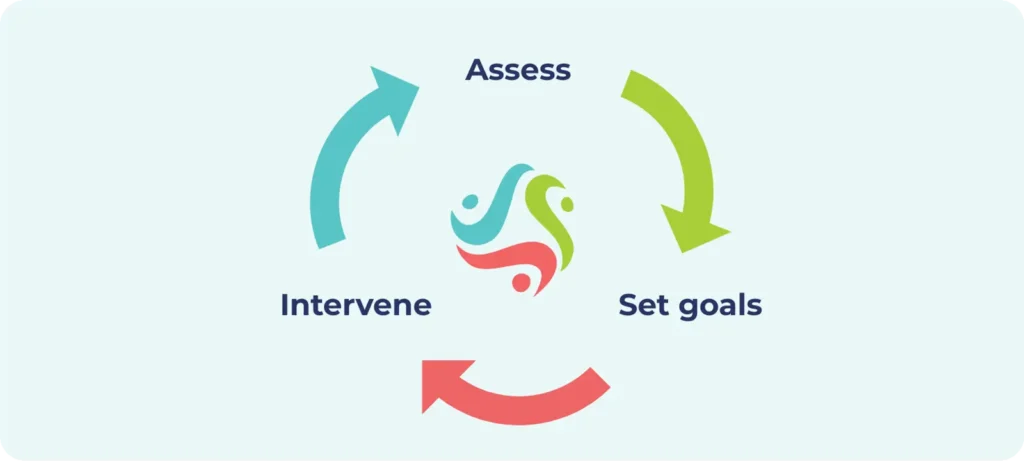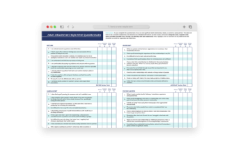Embarking on any journey requires the right map. Therapy is no different—except here, the map is co-created with the client as the journey unfolds. We mark significant events as landmarks, trace the highways they’ve traveled, and explore the roads they hope to take. Assessment becomes the clinician’s cartographer’s tool: the more we understand about a client’s history, struggles, and inner strengths, the clearer the picture of their path toward wholeness.
Seen in this light, assessment is far more than a starting point or a stack of intake forms. It is a therapeutic practice in itself—one that helps clinicians recognize symptoms that need care, patterns that shape behavior, and resources that can be strengthened. With accurate assessment, we can set goals that are not only clinically sound but also deeply attuned to each client’s lived experience.
What Every Therapist Should Know About Right-Brain Processing
What Makes a Good Assessment and Why Does It Matter?
A good assessment goes beyond simply gathering data—it helps us cultivate a fuller picture of the person in front of us. To do this well, therapists need to look beyond surface-level symptoms or self-reports and attempt to understand the larger story of the client’s experience.
In his book Attachment, Trauma, and Healing, Dr. Terry Levy tells us that an effective assessment has three qualities: it respects the context of the client’s life, it explores multiple dimensions of functioning, and it draws from diverse methods. Culture, family systems, and social environments all play a role in shaping a person’s challenges and resources. Likewise, looking at emotional, cognitive, behavioral, and physical patterns together provides a more holistic view than focusing on one area alone. And by combining interviews, observation, standardized tools, and input from different settings, we create a more accurate and nuanced map.
This matters because the quality of assessment shapes everything that follows. When we understand a client’s context and complexity, we avoid pathologizing what may be adaptive responses to past environments. We also identify strengths that can be harnessed in therapy, building recognition and compassion for the resilience that has carried them this far. Most importantly, a well-rounded assessment sets the stage for treatment goals that feel relevant and achievable, rather than imposed or disconnected from the client’s lived reality.

The Three Pillars of Assessment
While the intake and assessment process will look different for each client, there are some core areas of focus that ensure effective assessment and diagnosis in the context of attachment adaptations and interpersonal trauma. Dr. Terry Levy describes these as the three pillars of a comprehensive assessment: developmental history, current symptoms, and attachment patterns with caregivers. Together, they provide a framework for understanding both where clients have been and what supports their healing journey forward.
Developmental History
Exploring a client’s developmental background helps us see the conditions that shaped their earliest experiences. This may include family dynamics, prenatal and postnatal health, attachment experiences, and the role of significant relationships. It also invites us to notice the client’s strengths and inner resources—how they adapted, survived, and made meaning. A developmental history can illuminate an internal working model: the beliefs clients carry about themselves, others, and the world around them.
Symptoms and Diagnoses
Assessment also involves identifying current (or past) challenges across multiple domains. Behavioral signs might include aggression, withdrawal, or risk-taking. Cognitive symptoms may appear as negative self-talk, poor concentration, or distorted beliefs. Emotional difficulties often show up as depression, anxiety, or emotional numbing. Social challenges could involve conflict with peers, difficulties in intimacy, or isolation. Physical manifestations, from chronic pain to sleep disturbances, can easily take up a great deal of a client’s experience—draining their system of energy and hope. Noticing these diverse expressions helps ensure treatment addresses the whole person, not just one facet of their distress.
Attachment History with Parents and Caregivers
Finally, understanding a client’s attachment history offers critical insight into their relational blueprint. This includes their “life script”—the repeating patterns that play out in relationships over time. It can also involve exploring parents’ own attachment histories, attitudes, and caregiving skills, since these often shape how secure or insecure the client’s early bonds became. Such exploration brings clarity to where difficulties may have originated, but also highlights opportunities for new corrective experiences in therapy.
The Ongoing Process of Assessment
It’s sometimes easy to see assessments as something we do as part of a client intake—then file away with other notes, unlikely to be seen again. We might land upon a diagnosis or a label that becomes a lens through which we see the client—”they have anxiety,” “they’re oppositional”
If this sounds familiar, it might be helpful to reconceptualize assessment as a dynamic process that unfolds throughout treatment. As trust grows, clients often share new information or show sides of themselves that weren’t visible in the early sessions. Ongoing assessment allows clinicians to update their understanding, refine treatment goals, and adjust interventions as needed.
What’s more, trauma presentations and attachment disruptions exist on a spectrum of severity. For some clients, the signs are subtle: mild difficulties with trust, occasional anxiety in close relationships, or a tendency to avoid vulnerability. For others, the impact is more profound—patterns of disorganized attachment, deep-seated fears of abandonment, or relational trauma that affects every aspect of functioning.
Revisiting our clients’ experience of (and relationship to) their individual challenges can offer ongoing insights, opportunities for deeper processing, or unexpected resilience or growth. In practice, this means assessment is best understood as cyclical: we assess, set goals, intervene, and then reassess. Each cycle provides fresh insight into what’s working, what needs adjusting, and how the client’s inner map of relationships is changing.

Mapping the Way Forward
Assessment provides a way to orient for both client and clinician within the landscape of healing.. When clinicians approach assessment as an ongoing, collaborative process, they create space for clients to be recognized in the fullness of their history, strengths, and potential. Assessment then serves not only as the starting point of treatment, but as a compass that continues to guide the path toward wholeness.





Ready to Begin Your Healing Journey?
Browse on-demand courses and begin learning from top experts today!


